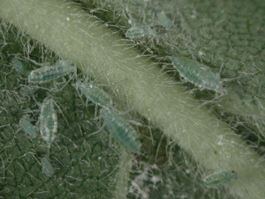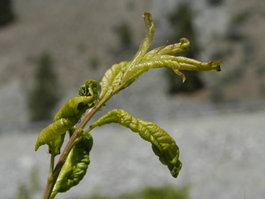Hop aphid
Phorodon humuli (Schrank)
Leafcurl plum aphid
Anuraphis helichrysi (Kaltenbach)
Mealy plum aphid
Hyalopterus pruni (Geoffroy)
Rusty plum aphid
Hysteroneura setariae (Thomas)
Thistle aphid
Brachycaudus cardui (Linnaeus)
Several aphid species attack stone fruits in the Pacific Northwest. The black cherry aphid and the green peach aphid are the most important. However, the less common aphids listed above can cause occasional damage.
Hosts
- Hop aphid: apricot and plum
- Leafcurl plum aphid: plum
- Mealy plum aphid: apricot, peach and plum, except Japanese hybrid plums
- Rusty plum aphid: cherry, peach and plum
- Thistle aphid: apricot and plum
Life stages

Hop aphid
The wingless form is teardrop shaped and pale yellowish green to dark green. The winged female is pale yellowish green with a dark head and thorax. The male is smaller than the female. It has a black head and thorax and a dark green abdomen.
Leafcurl plum aphid
The “stem mothers,” which hatch from eggs in the early spring, are dark green or reddish with brown dorsal bands. Nymphs and adults born from the stem mothers are pale green. The female that lays eggs in the fall is dark green or reddish with brown bands on its back.
Mealy plum aphid
The adult is pale bluish green and has a white, powdery coating that makes it look gray to light green.
Rusty plum aphid
This aphid is rusty brown or deep purple with white bands on the legs.
Thistle aphid
This is a fairly large, shiny green aphid with black markings on its back.
Life history

Overwintering eggs are laid in crevices on twigs. They hatch just before bud break. The nymphs develop into wingless females, which produce young without mating. The aphids feed on the undersides of leaves. As numbers increase, the leaves curl.
After 2 or 3 generations, winged forms are produced. They migrate from tree fruits to summer hosts, which include weeds, ornamental plants and vegetables. There, they produce several more generations. In the fall, winged migrant aphids return to their tree fruit hosts and give birth to nymphs, which develop into egg-laying females. These females mate with males returning from summer host plants and produce eggs that overwinter.
Damage
The aphids colonize young terminal growth. Infested leaves may curl and terminal growth can be disrupted. The aphids produce copious amounts of honeydew, which coats leaves and fruit with a sticky film. A black fungus, known as sooty mold, grows on the honeydew, impairing fruit quality.
Monitoring
It is important to monitor for these aphids shortly before bud break, as management decisions must be made at that time. The aphids are best controlled when small and exposed.
Biological control

Several insect predators help to keep these aphids in check in a well balanced ecosystem. However, a certain number of aphids must be present to attract the predators, which means some damage can be expected. The most common aphid predators include lady beetles, lacewing larvae, syrphid fly larvae, soldier beetles and predacious midges. Since mealy plum aphid has only two summer hosts – reed grass and cattails – it may be feasible to control this aphid by eliminating the alternate hosts. However, as mealy plum aphids can migrate up to 30 miles, this is only practical where there are few alternate hosts around.
Management
These aphids are generally not a problem when a regular spray program is used to control other insects. The most effective of these programs would be a delayed-dormant spray of oil with an appropriate pesticide. After the aphids become active and leaves begin to curl they are more protected and harder to control. Attempts at late season control can disrupt predators.
Low populations in the orchard early in the season may be beneficial in attracting predators. Later in the season, predators and migration to summer hosts should keep populations at acceptable levels.
